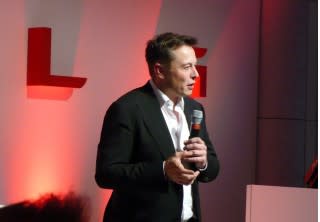Tesla Model S Double-Pedal Behavior Still Inconsistent: A Safety Plea To Elon Musk
![Tesla Model S in Albuquerque's 'snowstorm' during NY-to-California road trip [photo: David Noland]](https://s.yimg.com/ny/api/res/1.2/4JduqjXz2DnW_LBmajL.bQ--/YXBwaWQ9aGlnaGxhbmRlcjt3PTY0MDtoPTQ4MA--/https://s.yimg.com/os/en_US/Autos/GreenCarReports/tesla-model-s-electric-car-road-trip-upstate-new-york-to-southern-california-photo-david-noland_100500017_s.jpg)
Last summer, I wrote an article patting Tesla Motors CEO Elon Musk on the back for being so responsive to Model S electric-car owners.
Of whom I am one.
But in 2015? Not so much.
I ended that article with a plea to Musk for a safety upgrade on the Model S: a firmware change to cut off power to the wheels if the driver inadvertently presses the accelerator pedal while braking.
DON'T MISS: Tesla CEO Elon Musk's Personal Touch: Secret To His Success? (Aug 2014)
Due to the close spacing of the brake and accelerator pedals in the Model S, this is more likely to happen in the Tesla than most other cars.
It’s happened to me several times--I have big feet--which is what led to my writing about it a year ago.
![Tesla Model S electric-car road trip, Route 66 Museum, Elk City, Oklahoma [photo: David Noland]](https://s.yimg.com/ny/api/res/1.2/m8y3D5G5qerp8LoVBoE2xA--/YXBwaWQ9aGlnaGxhbmRlcjt3PTY0MDtoPTUwMA--/https://s.yimg.com/os/en_US/Autos/GreenCarReports/tesla-model-s-electric-car-road-trip-upstate-new-york-to-southern-california-photo-david-noland_100500016_s.jpg)
And at last count at least 17 different Model S owners had reported the same thing on Tesla forums.
The both-pedals-pressed syndrome drastically lengthens stopping distance, and can be potentially hazardous.
ALSO SEE: Life With Tesla Model S: UPDATE On Pedal Placement Problem (Mar 2014)
Ironically, the only accident I’m aware of that can clearly be attributed to the double-pedal problem—a minor front-end bash—occurred at a Tesla-sponsored test-drive event at the factory.
In writing that article, I was hoping Musk would respond as quickly and fully as he did to a previous plea for an extended powertrain warranty for the Model S.
In that case, last August, Elon announced a 10-year, infinite-mile warranty on the Model S drive unit just seven days later.

Quick response, but confusing
Sure enough, Elon’s response to my plea for a power cut-off when both pedals are pressed was quick.
The very same day, he tweeted to his one-million-plus followers, “Model S limits torque if brake and accel simul pressed. Going to zero torque with brake press would be a safety hazard.””
MORE: Tesla Model S Drive-Unit Replacements: How Big A Problem? (Aug 2014)
But for me, Musk’s tweet raised more questions than it answered.
To what level was the torque limited, and under what conditions?
![2014 Tesla Model S P85D, road test, Dec 2014 [photo: David Noland]](https://s.yimg.com/ny/api/res/1.2/83I_tFWKrXcSsVYz6bkrKg--/YXBwaWQ9aGlnaGxhbmRlcjt3PTY0MDtoPTQzMg--/https://s.yimg.com/os/en_US/Autos/GreenCarReports/2014-tesla-model-s-p85d-road-test-dec-2014-photo-david-noland_100494832_s.jpg)
And how exactly would “going to zero torque with brake press” be a safety hazard?
What confused me the most, however, was this: Musk’s tweet simply didn't jibe with my own testing of my car.
Power cuts off...sometimes
I’ve found there are two completely different both-pedals-pressed situations in the Model S.
And the car responds differently to each one.
1. When the accelerator pedal is the first one pressed--say, if you're driving along with your right foot on the "gas" and you then step on the brake pedal with the left foot--the power appears to cut off completely.
The orange power arc drops to zero and the car slows immediately.
![Tesla Model S in Albuquerque's 'snowstorm' during NY-to-California road trip [photo: David Noland]](https://s.yimg.com/ny/api/res/1.2/4JduqjXz2DnW_LBmajL.bQ--/YXBwaWQ9aGlnaGxhbmRlcjt3PTY0MDtoPTQ4MA--/https://s.yimg.com/os/en_US/Autos/GreenCarReports/tesla-model-s-electric-car-road-trip-upstate-new-york-to-southern-california-photo-david-noland_100500017_s.jpg)
Is this what Musk meant by the torque being limited? How is it merely "limited" if the power meter goes to zero?
This appears to be precisely the zero-torque condition that Musk tweeted would be hazardous.
2. But when the brake pedal is the first one pressed, followed by the accelerator--as in the potentially dangerous inadvertent both-pedals-pressed situation that I and other Model S owners have experienced--the torque does not cut off, or even appear to be significantly limited.
In my own brake-then-accelerator tests, I saw 160 kW indicated on the power meter with both pedals pressed in this manner--and that was with only partial application of the accelerator.
That's hardly "limited": 160 kW is the equivalent of 215 hp, or about eight times the power required to maintain a steady 60-65 mph.
(Unfortunately, I lacked the nerve to floor the accelerator completely during these tests to find whether maximum power is available with the brakes on.)
Frankly, Musk’s Twitter response had me totally baffled.
It flew in the face of my real-world experience with the car, and simply didn’t make much sense without further explanation.
More than a tweet
Realizing that 140 characters are hardly enough to discuss a complex issue like this one, I sent Musk an e-mail asking for clarification of his tweet.
Over the past couple of years, he’s quickly responded to several previous e-mails of mine, so I had at least some hope of a more detailed response.

 Yahoo Autos
Yahoo Autos 
